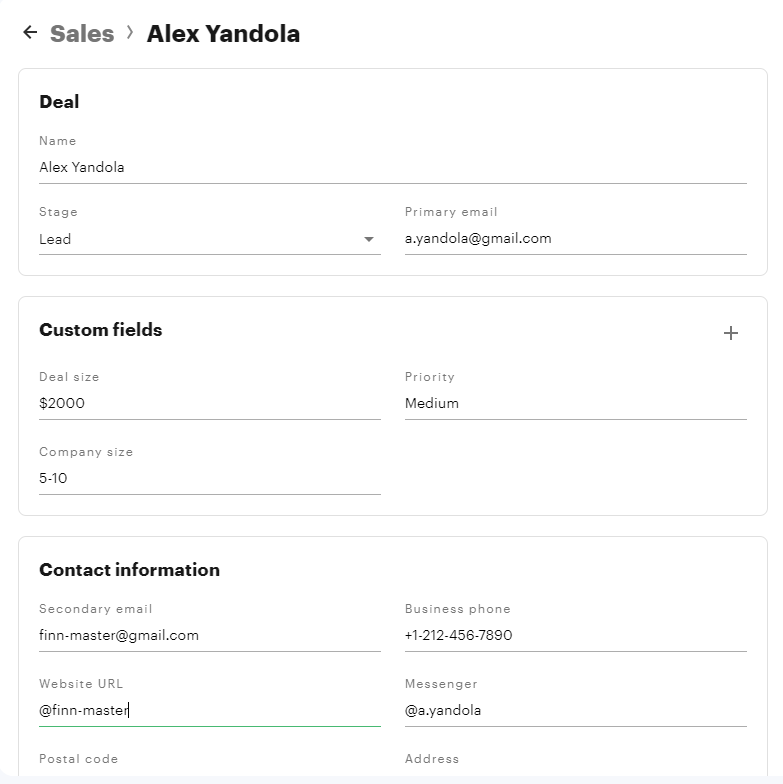Lead management is a vital process for many businesses. Without a consistent stream of new customers, your business won’t be able to grow and develop. Without growth, your business will likely fail. This is why the majority of marketers consider lead generation as one of the most difficult tasks and a top priority.
In this article, we’ll take a closer look at the sales lead management process. We’ll also look at how using CRM for lead management improves and streamlines the process. Keep reading to discover how you can improve sales and the customer’s experience with your business.
What Is Lead Management?
Before you can successfully implement a lead management strategy, you need to understand the definition of lead management. If you’re wondering, ‘What is lead management?’, the answer is quite simple. Lead management entails all the processes involved in moving consumers through your sales pipeline.
These processes cover every step of the buyer’s journey, from lead acquisition to conversion and sales. As simple as the process seems, implementing a successful strategy can be more daunting than expected, especially in this modern age of technological advancements. Using a lead management CRM is the best way to ensure that all the processes related to your customers are covered in the most efficient way possible.
Lead management in CRM makes it possible for businesses to capture new potential clients, enrich and qualify them, distribute them amongst sales managers, and nurture them most efficiently and productively.
Why Is Lead Management Important for Your Business?
Now that we’ve covered what sales lead management is, it’s essential to know why it’s important for businesses. Lead management is considered the art of turning potential customers into actual ones by guiding them to make a purchase. If this process, or the various parts of it, aren’t managed effectively, it could mean that sales fall through the cracks and consumers are neglected.
Setting up an effective sales lead management strategy is important because:
- A lot of time and resources go into nurturing potential clients
- Wasting potential clients means losing sales opportunities
- It drives sales and conversions
- It helps streamline and automate certain processes to save time
- It streamlines the productivity and efficiency of the sales team
A good way to ensure that you have an effective strategy in place is to use CRM for lead management. CRM software enables businesses to stay on top of all acquired potential clients. By using this software, you can monitor where a potential customer is in the sales pipeline and nurture the process accordingly.
Benefits of Lead Management
Regardless of the size of your business, a successful lead management strategy can have numerous benefits for your business. Some of the benefits of successfully implementing this strategy include:
- Establishing an immediate relationship with new potential clients
- Monitoring and staying in touch with potential clients throughout the buying journey
- Efficient lead tracking, scoring, and qualification
- Save your business time and money
The Process of Using CRM for Lead Management – 6 Simple Steps
By this point, you’re probably wondering how to manage leads using CRM. It’s quite simple if you remember that there are various stages involved in lead management. A CRM system can help improve these stages in different ways. Let’s take a look at each process and how CRM software can be utilized to benefit that stage in the sales funnel.
Step 1: Capture
Lead capturing is one of the most important factors for your business. CRM can be very beneficial in this process as it makes prospecting for new clients easier. Because these tools store all your client data in a centralized location, you can get a clearer idea of your Ideal Customer Profile (ICP).
You can use your CRM to:
- Identify patterns and commonalities between clients
- Identify clients that you upsold to
- Understand why deals were lost
Step 2: Enrichment
Customer data is a valuable asset to many businesses. The data you collect has a direct impact on how you interact with specific clients. It also has an impact on how you attract new potential customers. Due to the importance of customer data, the information you collect must be relevant, updated, reliable and complete.
CRM can help you enrich your customer data in various ways. Not only can sales and marketing teams manually input data that becomes centrally available. The software also offers many integration options, such as integrating with Facebook, Instagram, LinkedIn, and more. The software is then able to extract public data from these sources to enrich your customer profiles.

Step 3: Qualification, Scoring, and Prioritization
As we mentioned earlier, not all potential clients are equal. Not all leads will become sales. This is part of business, but to ensure you don’t waste too much time on the wrong clients, it’s important to have a way of scoring prospective clients. You need to be able to identify the most valuable potential customers so that your teams can focus on nurturing them.
Manually scoring potential clients not only takes a lot of time and effort, but they’re often inaccurate. CRM systems can score customers much faster and more accurately based on a set of qualification rules for your particular business. You set this up by outlining the rules and customizing your system to attribute numerical values to all new leads as they come in. Sales teams can then prioritize their time based on these scores.
Step 4: Distribution
When it comes to securing potential clients, speed is your friend. The faster your sales team responds, the more likely it is that the client will choose your business over competitors. If you want to beat out the competition and maintain a competitive edge, you must respond to any leads as quickly as possible. Any delays can mean a lost sale.
CRM helps streamline this process by automatically assigning the clients to a sales rep. Automating this process means there are no delays when a potential client comes in – even if that happens to be at midnight. You’re able to set up most CRM systems to automatically distribute leads based on a set of predetermined criteria or in a round-robin fashion.

Step 5: Nurturing
The next step in the management process is lead nurturing. While sales teams should focus on high-quality clients first, that doesn’t mean the others can just be ignored. You never know the full potential of a client until you start nurturing the relationship.
You can use CRM tools to create a workflow that will ensure all of your leads are contacted and guided along the sales funnel. The CRM makes it possible to customize and personalize communications with your leads across multiple channels. More importantly, it gives your sales team an overview of where in the process the client is and what needs to happen next to move them along.

Step 6: Conversion
The final step of a successful lead management strategy ends with a sale. Your strategy has proved effective as soon as a lead becomes a customer. At this point in the process, your CRM will enable you to keep all of the client’s data in a centralized location so that you can reach out to them with promotional offers in the future.
Final Thoughts
Now that we’ve addressed what lead management in CRM is, it’s apparent that to ensure the success of your business, you need to utilize the right tools. A CRM system ensures a better customer experience and streamlines and improves how your team nurtures clients throughout the sales journey.
If you’re thinking you don’t have the budget for a CRM, think again. The free InboxCRM from PandaDoc browser extension provides the basic features of a customer relationship management tool straight to your Gmail inbox. Look at the tool now and start improving your lead management.
FAQs
-
Lead management in CRM is the process of using specialized software to help acquire and manage new leads throughout the sales process until they make a purchase. CRM systems are beneficial during the process as they can streamline the process and automate certain steps.
-
A lead is a potential sales opportunity. This could be someone who sent an inquiry or displayed an interest in your products or services but hasn’t made a purchase yet. Not all leads will become sales, but with the right management strategy, you can maximize your efforts and increase the amount of sales.
-
The lead management process has a few aspects that can be addressed by CRM software. CRM software can help you generate new leads by identifying your Ideal Customer Profile (ICP). They can also score your leads which will make prioritization easier. The software can also improve the sales pipeline by automatically distributing leads and adding workflows to ensure no leads are missed or forgotten.


